The Type 23 or “Raubvogel” (bird of prey) class were the first six destroyer-size ships build in Germany after World War I, voted by the parliament for the Reischmarine to replaced six of the 12 Versailles authorized destroyers reaching their age limit. They were part of a replacement program that also included the cruiser Emden. For the first time, electrical welding was used in construction to decrease weight and if they were inspired by late World War I designs they were the first t take advantage of a new generation of geared turbines, with very high efficiency. Still experimental, they tested turbines from different manufacturers. Later reclassed as torpedo boats while under the Kriegsmarine they took part in the Spanish civil war operations, and in World War II, served in the Channel and were present in many operations as escorts. The survivors received extra AA and FuMo and FuMB radars in 1943.
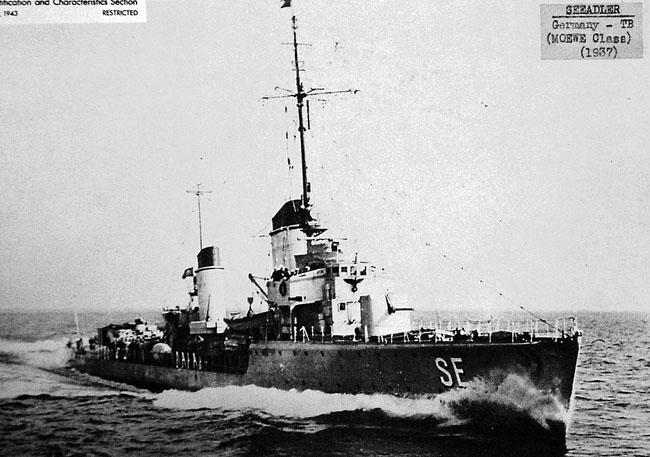
Development
The Type 23 torpedo boat for their order date (1923) was a group of six torpedo boats built for the Reichsmarine during the 1920s. To put this into context, the Versailles Treaty capped the new Germany Navy to the size of a scandinavian defensive fleet. In numbers this meant 15,000 personal, including administrative and support on land, a strenght of six pre-dreadnought battleships, six light cruisers, twelve destroyers, and twelve torpedo boats with replacements restricted to a maximum size of 10,000 tons. Interdiction to built submarines or aircraft. This was way more restrictive than the Washington treaty, which capped cruisers at 10k tons. The Reichsmarine had to make due with these, provided they could be replaced after twenty years of service, for funds to be obtained at the Reichstag. Ships were maintained thus “in active service” even though they saw little activity aside basic training and short cruises for some. Tbe goal was to “consume” service time, added to their age. In 1923, it was planned already to replaced the six oldest destroyers in a first batch FY1923, followed by another FY1924. These became the “raubvogel” and “raubtier” according to their name.
For this new generation of destroyer, as well as for a new cruiser (Emden) German engineers had to look to previous designs. Emden was an enlarged version of the WWI Köln (ii) class, but already innovated in construction and powerplant aspects. These ships were seen as a stopgap to rebuilt shipbuilding skills and capabilities, and catchup with the latest manufacturng techniques. It was hoped by the Reichsmarine cadree that somewhat in the late 1930s the Versailles treaty could be renegociated and then German shipyards would be ready for better, larger ships.
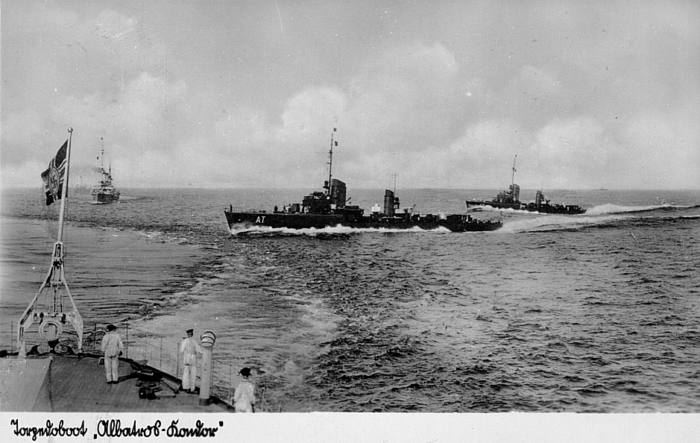
For these six new destroyers, there was no time to develop a brand new design from scratch. There were already several good dlate war designs that could be used as a starting point. The large SMS H145 of the G96 class was a good starting point. H145 was scuttled at Scapa Flow in 1919 but plans were still available. The G96 class (1916 Mob.) were 990t ships, 84.5 x 8.4 x 3.4m (277 ft 3 in x 27 ft 7 in x 11 ft 2 in) with 2 steam turbines and a cruising turbines, three boilers for 24,000 PS (24,000 shp; 18,000 kW) and 32 knots (37 mph; 59 km/h). They were armed with three 10.5 cm L/45 guns and six 50 cm (19.7 in) torpedo tubes.
The Reichsmarine staff under Vizeadmiral Paul Behncke wanted a repeat of this design instead of the outlandish 1918 S113 class with their four 15 cm guns. Not only on trials in the last months of the war they showed to be overweight and unstable, but would have assumed to have been flagged by the allied commission. The S113 looked far more reasonable and transitional. As a result plans were retaken and reworked for the Type 23, made slightly larger but with similar armament and speed. Most of the innovations would be in construction and powerplant design. On trials, they would show a propention to be much “drier” than the older design, but still had a lot of weather helm and proved difficult to stay on course at low speed in rough conditions. The design was later not exempt of critics, and some of its shortcomings were corrected by the follow-up Type 1924. Nevertheless the twelve new “destroyer” later to be reclassed as TBs, were an important step for the Reischmarine towards much larger designs such as the 1934 Type under the Kriegsmarine, almost ten years later.
When launched, they made a sensation as being racy, modern ships while not being a concern for the allied commission.
Design of the class
A gradual approach was taken for their design. One would be used as a prototype for the other five. This was the lead boat of the Type 1923, Möwe.
Hull and general design
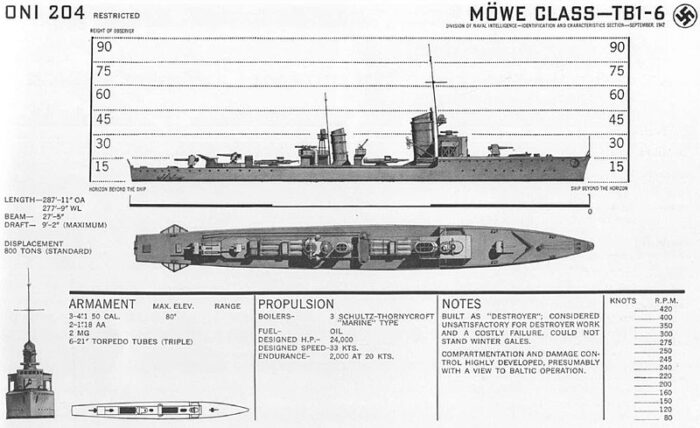
Depiction of the class, ONI
The first ship ordered, Möwe, was slightly smaller: Overall length of 87 meters (285 ft 5 in) or 3 meters more than the G96 design, and 84.7 meters (277 ft 11 in) long at the waterline due to her round cruiser stern. Her sisters were built instead with a flat transom stern. Their own overall length was 87.7 meters (287 ft 9 in) but with a shorter waterline length of 85.7 meters (281 ft 2 in). Beam was 8.25 meters (27 ft 1 in) -again versus 8.4m or 27 ft 3 in on the G96- so they were narrower. Their mean draft was 3.65 meters (12 ft) versus 3.4m (11 ft 2 in) on the G96. This made them slightly lighter at 923 long tons (938 t) -versus 990t- but 1,290 long tons (1,310 t) deep load in the new treaty measurements standards. Möwe herself was lighter at 798 long tons (811 t) or 1,213 long tons (1,232 t) fully loaded. In all cases, they had their hull divided into 13 watertight compartments and fitted with a double bottom over 96% of length.

Detailed design:
The forecastle was about 1/3 of the total hull lenght. The beam was progressive, reaching its apex amidships. The bow had fine entry lines and bit of flare, more than its G96 ancestor. For stability reasons, the three main guns were distributed in a way a single one retained on the forecastle, shielded, more agaionst the weather than anything else, and the two others aft, in a semi-superfiring position. In reality “Y” gun was on a half-deck tall platform. The full quarterdeck house was located behind with the gun muzzle just clear of the roof. “X” gun was on deck, shielded. Y was not. The rest of the design wa spretty standard, with a raised platform and breakwater on which was installed “A” gun, the bridge was two stages tall and enclosed with squared wings shorter than the main beam. The deck was raised further immediately aft of the narrow enclosed bridge (no open bridge) supporting the forward telemeter, with a patform supporting a projector after of the bridge, and raked foremast between the bridge and funnel at the forecastle break.
Behind these on a raised deck was located “A” torpedo tubes banks, then a twin bandstand for single FLAK 2cm guns, and the smaller, second funnel, also raked and capped as the forefunnel, and lower. Behind iot was located the aft structure and lower mainmast where ended wireless radio cables. There were a raised deck with observer positions, the torpedo fire control system,, and raised platform for a second projector. Then came “B” torpedo tubes bank, the half-deck quarterdeck house with a small aft radio room and telemeter on top, then “Y” gun, the full deck aft wheelhouse and “X” deck gun. The deck was wooden all the way to the stern, but stopped short of a metallic deck at the poop. There were mines rails only on starboard. The crew amounted to 4 officers and 116 sailors and the ships had four boats and lift rafts. Two were captain’s cutters wetted by using a crane close to the bridge, and two inverted whalers on deck close to the aft funnel.
The firemast supported a square based spotting top accessible through ladder steps welded on the mast. There were two anchors forward only. The transom stern was splitted close to the waterline for finer exit lines.
Powerplant
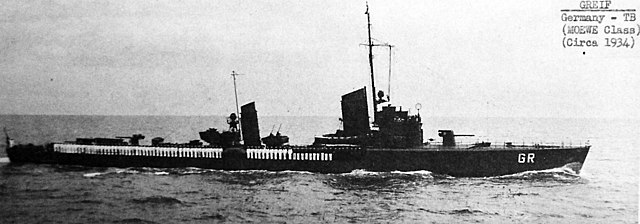
The Type 1923s were the first German ships to use geared steam turbines instead of simpler steam turbines as on previous designs. They actually had two sets of turbines which drove each a single three-bladed, 2.5-meter (8 ft 2 in) propeller. Steam came from three water-tube boilers, operating at a pressure of 18.5 kg/cm2 (1,814 kPa; 263 psi). Turbines could produce up to 23,000 metric horsepower (17,000 kW; 23,000 shp), copmparable to the older G96, and for a better speed of 33 knots (61 km/h; 38 mph) thanks to finer hull lines, narrower beam, and just the turbines being more efficient for the same output.
On trials they managed even faster speeds, from 33.69 to 31.65 knots (62.39 to 58.62 km/h; 38.77 to 36.42 mph). They carried 321 tonnes (316 long tons) of fuel oil for a range of 1,800 nautical miles (3,300 km; 2,100 mi) at 19 knots (35 km/h; 22 mph). However on trials they showed to be not that good steamers, having this contracted range only and not better. This was criticized later and the Type 1924 were modified for more power and range.
Armament
10.5-cm SK L/45
As built, the Type 1923 had three 10.5-centimeter (4.1 in) SK L/45, which were 42-caliber guns. “A” on the forecastle, “Y” and “X” aft on the the superstructure. These guns were a pre-WWI design which was reliable and accurate, albeit labor-intensive.
Weight and size: 1,450 kg (3,200 lb), 4.725 m (15 ft 6.0 in)
Elevation: -10° to +50°
Shell: 17.4-kg (38 lb) HE Muzzle velocity 710 m/s (2,300 ft/s)
Later the guns were altered to fire SK C/32 ammunitions: 15.1 kilograms (33 lb), muzzle velocity of 785 m/s (2,580 ft/s)
Range: 15,175 meters (16,596 yd) at 44.4°.
100 shells were provisioned per gun.
2-cm FLAK C/30 (1931)
Two 2-centimeter (0.8 in) C/30 anti-aircraft guns were added after 1931 located in individual posts aft of the bridge.
Weight and size: 450 kg (990 lb), 4.08 m (13 ft 5 in).
Rate of fire: 120 rounds per minute practical, 280 cyclic.
Shell: 0.12-kilogram (0.26 lb) HE, muzzle velocity 875 m/s (2,870 ft/s)
Ceiling 3,700 meters (12,100 ft)
Range 4,800 meters (5,200 yd).
2,000 rounds provisioned per gun.
50 cm TTs
As completed the Type 1923 only had three main guns and two triple torpedo tube banks. These were the classic 50 cm (19.7 in) torpedo tubes compatible with WWI models such as the 50 cm (19.7″) 1913 G7 still in large stocks.
Weight: 3,009 lbs. (1,365 kg)
Dimensions: oa 276 in (7,020 m) x 19.7 in (50 cm).
Warhead: 430 lbs. (195 kg) Hexanite
Range/Speed settings: 4,370 yards (4,000 m)/37 knots and 10,170 yards (9,300 m)/27 knots
Power: Decahydronaphthalene (Decalin) Wet-Heater.
After 1931, they were replaced by larger 533-millimeter (21 in) tubes for the G7a torpedo:
Weight: 3,369 lbs. (1,528 kg), Negative Buoyancy 605 lbs. (274 kg)
Dimensions: 23 ft. 7 in. (7.186 m)
Propulsion: Decahydronaphthalene (Decalin) Wet-Heater
Warhead: 617 lbs. (280 kg) Hexanite.
Guidance: Federapparattorpedo; 1944 Lagenunabhängiger Torpedo
Warhead: 300-kg (660 lb)
Speed/range settings: 14,000 m (15,000 yd)/30 knots; 8,000 m (8,700 yd)/40 kts; 6,000 m (6,600 yd)/44 knots.
Mines
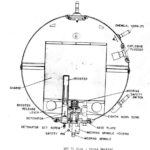 They could also carry up to 30 mines. These were likely EMC Contact Mines, placed on trolley rails. Spherical mines, 44 inch (1.12 m) in diameter. Charge 661 lbs. (300 kg). 7 Hertz horns. Could be moored in 55, 109, 164 or 273 fathoms (100, 200, 300 or 500 m). First captured by the British in October 1939. more on navweaps
They could also carry up to 30 mines. These were likely EMC Contact Mines, placed on trolley rails. Spherical mines, 44 inch (1.12 m) in diameter. Charge 661 lbs. (300 kg). 7 Hertz horns. Could be moored in 55, 109, 164 or 273 fathoms (100, 200, 300 or 500 m). First captured by the British in October 1939. more on navweaps
Upgrades (1941-44)
Wartime additions: Two more 2 cm guns in single mounts forward of No. 2 gun. Late 1942, replaced by a single flakvierling (quadruple 2 cm mount). Three 2 cm guns were alo repositioned around the aft funnel and two more mounted on the bridge wings, one in front of the bridge in single mounts.
Sensors (1944)
FuMB Ant 4 “Sumatra”
FunkMessBeobachtung: Passive Radar detector. Broad-band diagonal antennas. 1943, broadband dipole. It has flat, drop-shaped branches mounted in front of a reflecting area. In order to receive horizontally as well as vertically polarized waves, the dipole is tilted. Its reception angle is +- 50 degrees. To be able to survey the whole area, the antennas of the Sumatra installation are mounted on all four sides of the ship.
FuMO 63
FunkMessOrtung. Active Radar. Could be detected. Small type, Hohentwiel-K.
⚙ specifications |
|
| Displacement | 811-938 t standard, 1,232-1,311 t deep load |
| Dimensions | 87-87.7 m x 8.25 x 3.65 m (285 ft 5 in/287 ft 9 in x 27 ft 1 in x 12 ft) |
| Propulsion | 2 shafts GS Turbines, 3× water-tube boilers: 23,000 shp (17,000 kW) |
| Speed | 34 knots (63 km/h; 39 mph) |
| Range | 1,800 nmi (3,300 km; 2,100 mi) at 17 knots (31 km/h; 20 mph) |
| Armament | 3× 10.5 cm (4.1 in) guns, 2×3 500 mm (19.7 in) TTs, 30 mines |
| Crew | 127 |
Assessment
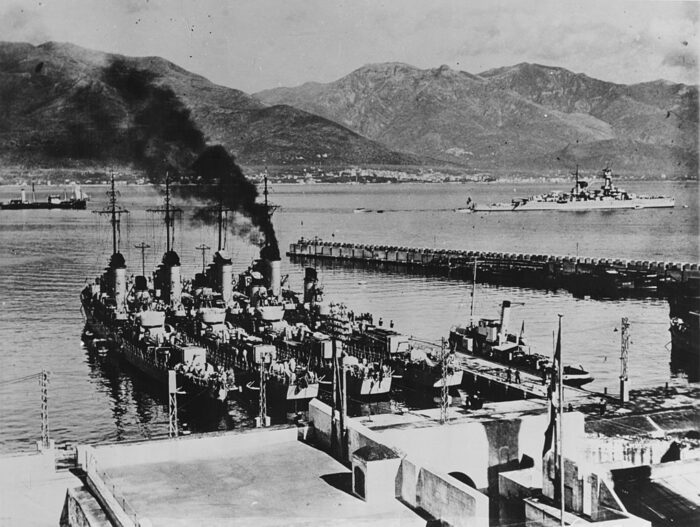
As part of the renamed Kriegsmarine, thes ships started their career with non-intervention patrols in the frame of the Spanish Civil War as a good training in another theater in 1936-39. They were mostly assigned to the 4th Torpedo Boat Half Flotilla before that from 1926-28 up to late 1936 when the Kriegsmarine reorganized its torpedo boats into flotillas: Albatros and Seeadler ended in the 2nd Torpedo Boat Flotilla, Falke, Greif, Kondor and Möwe to the 4th Torpedo Boat Flotilla. After KMS Deutschland was bombed by Republican aircraft on 29 May 1938, Adolf Hitler ordered Admiral Scheer to shell Almería, two days later, and she was escorted by the 2nd Flotilla which included Seeadler and Albatros. By June 1938, a new reorganization saw Seeadler sent to the 4th Flotilla, Greif, Kondor and Möwe to the 5th Torpedo Boat Flotilla and they were soon in refit and/or reserve.
As World War II flared up, the “raubvogel” escorted minelayers in early minefield missions. The 4th Flotilla was disbanded, Seeadler was transferred to the 6th Torpedo Boat Flotilla. After the North Sea minelaying mission from 3 September 1939, Albatros, Falke and Greif were sent for anti-smuggling patrols in the Kattegat and Skaggerak on 3-5 October, capturing four ships. On 13, 18, 19 November, the 6th Flotilla was sent to escort the mission return of two light cruisers and destroyers from the English coast. They were back to patrolling the Skagerrak afterwards, inspecting neutral shipping for contraband goods. From 14 to 16 December, Seeadler, Jaguar returned to contraband patrols in the Skaggerak and searched six ships.
The Invasion of Norway from April 1940 saw them performing support missions, like Albatros, Kondor and Möwe on Oslo, Falke, Greif, Seeadler at Kristiansand and Aarendal. Albatros fired opening shots in this invasion, on a Norwegian patrol boat at the mouth of the Oslofjord on 8/9 April. She took part in the capture of Horten with Kondor but the same afternoon, Albatros ran aground and was left wrecked. Möwe carried troops to Oslofjord and rescued men from the sunken Blücher. Greif ferried troops to Arendal and with Seeadler at Kristiansand. Falke carried trops to Kristiansand. Greif later scuttled by torpedoes the badly damaged KMS Karlsruhe on 9 April. Lützow was was also torpedoed by a British submarine off the Danish coast and was assisted by the five remaining TBs.
Greif, Kondor and Möwe escorted minelayers to the Skaggerak. Möwe was torpedoed by a British submarine on 8 May, a detonation that blew her stern clean off but her bullheads held. She was towed to safety and repaired until 1942, with her poop rebuilt as a transom like her sisters. The remaining four continued to escort various ships through the Skaggerak, Kattegat and Norwegian waters, or minelayers. They were reorganized as the 5th Torpedo Boat Flotilla and were in the North Sea in August-September 1942 but also laid themselves a minefield in the English Channel twice in October, claiming four small Allied vessels. Nexct they were sent to St. Nazaire, France, to have an easier access to the southern channel in December.
After refits in early 1941 (Kondor, Falke and Seeadler) at Rotterdam, they were back to escorting ships in the Skaggerak and later returned to France in 1942 to help the “terrible sisters” (Scharnhorst class) for the Channel Dash. Later they helped to escort blockade runners, commerce raiders and submarines through the English Channel and Bay of Biscay, still from France, until mid 1943. Seeadler was sunk in such missions by early 1942. Greif spent time in Norwegian waters before heading for France in mid-1943.
Escort missions comprised for example the commerce raider Michel through the Channel and she managed with her to damage two British destroyers. Later this was the commerce raider Stier (12-19 May) but MTBs managed to sink Seeadler on the 13th. Möwe performed escortsd for ships from Bordeaux to Japan, in the dangerous Bay of Biscayn. Falke and Kondor escorted also SS Cortellazzo from Bordeaux in November 1942.
Greif escorted battleships from Trondheim to Altafjord while the Italian blockade runner Himalaya was escorted by Kondor in the Bay of Biscay and was forced back in heavy aerial attacks (9–11 April 1943). Greif escorte a cruiser from Trondheim to Kiel in April-3 May. Greif, Möwe, and Jaguar escorted minelayers in the North Sea and laid themselves minefields in the Channel on 4–6 June before being sent back for escorts in the Bay of Biscay, this time of U-boats until early August. Möwe, Kondor, Greif laid more minefields later that year.
In 1944 the same types of missions resumed, but Greif was sunk by the RAF, Kondor badly damaged (mine) in May. Falke and Möwe on 6 June made a night attack but were unk by British bombers in another mission later that month. Kondor was bombed by late July and left.
The 4th and 5th Torpedo Boat Flotillas, consisting Greif, Möwe, Kondor, Jaguar, and two other torpedo boats laid minefields in the Channel on 21 and 22 March 1944. A few days later, the flotilla laid a minefield on the night of 21/22 April. The following night the torpedo boats engaged British MTBs near Cape Barfleur and sank one of them. Between 26 April and 1 May, the flotilla laid five minefields in the Channel. Three weeks later, they were ordered to transfer from Cherbourg to Le Havre and departed on the night of 23/24 May. Greif, Möwe, Falke, Kondor and Jaguar were attacked by Allied aircraft early the next day and Greif was struck by two bombs. She sank a few hours later after being towed by Möwe. The 14/15 June, which sank Falke and Jaguar also badly damaged Möwe, which sank on 16 June while Kondor was decommissioned on 28 June, cannibalized in Le Havre to maintain ther sisters. She was declared a total loss after the 31 July and/or 2 August 1944 raid. Thus, none survived into 1945.
Does this made these ships looks bad ? Does it have anything related to their design ? Not even close. They were just victim of a gradual loss of air superiority by the Luftwaffe and earlier, by rogues submarines actions they were not prepared to face. Indeed, by design, they were pure torped boats, made to rush at their intended targets, delivered their torpedoes and fold back. They were absolutely not equipped to perform ASW patrols and instead were used as escorts most of their career. The Normandy raid and repelling British DDs was their only occasion to shine in a classic surface acction. But if the Channel dash was a success, mostly the product of British blunders, the raid in Normandy was a failure, as they achieved very little to show for.
So again, they were not a bad design, just a transitional one, a strange in-between the naval architecture of WWI and new developments leading to the mid-1930s Kriegsmarine. They were essentially a modified WWI design like early U-Boats or KMS Emden, so their benefits were beyond and above their limitations. They looked nothing like the true “Zerstörer” that would follow almost ten years later, neither to the Type 1935 Torpedo Boats which were completely new animals, less well armed and more versatile. They still could be useful given their speed and good armament for their size, but they remained a transitional, between two waters design that really were hard to fit in any Raeder’s doctrine by 1939. Never meant to carry a large AA, it’s not suprising most were lost to aircraft (Möwe, Falke, Greif). Later TBs were far better armed to face that threat.
Career of the Raubtier
 Möwe (1926)
Möwe (1926)

Möwe (Seagull) was laid down at Reichsmarinewerft in Wilhelmshaven, yard number 102, as prototype for the serie, on 2 March 1925, launched on 24 March 1926 and completed on 1 October 1926. Assigned to the 4th Torpedo Boat Half Flotilla by late this was the 4th Torpedo Boat (full) Flotilla and like the others she made several patrols off Spain. By June 1938 she ended in the 5th Torpedo Boat Flotilla. On 3 Deptember 1939 she escorted the North Sea minelayers. The Norwegian Campaign in April 1940 saw her in Group 5 (Konteradmiral Oskar Kummetz, flagship Blücher) bound for Oslo. She carried herself 114 men of the invasion force while escorting the heavy cruiser through the Kattegat and into Oslofjord. The Battle of Drøbak Sound saw her at the rear of the column through the fjord witnessing coast defenses obliterating Blücher at close range while close to the Oscarsborg Fortress. She unloaded her troops at Son and with her sister Kondor at 17:30 she took part in the occupation of Kopås and Husvik batteries. While approaching the main fort under a flag of truce Kapitänleutnant Helmut Neuss asked for its surrender but negociatons dragged on due to Colonel Birger Eriksen wanted to avoid both humiliation or a bloodshed. Next Möwe escorted KMS Lützow through the Oslofjord. She replaced Albatros (which ran aground, wrecked) and Lützow continued alone, only to be torpedoed en route by a sub. Möwe and Kondor later assisted her.
On 18 April, Möwe, Greif, Seeadler escorted minelayers (anti-submarine minefields) in the Kattegat. They laid another minefield in the Skaggerak on 29–30 April but en route, KMS Leopard was accidentally rammed by KMS Preussen and sank. On 8 May, Möwe was torpedoed by HMS Taku on 8 May. Her rounded was blown off and severed. She survived and ended in repair until October, she obtained the same stern as her sisters and was only back in operation by early 1942. She was transferred to France in May and by September–October, started to escort German blockade runners through the Bay of Biscay for Japan. On 3–7 May 1943 with Greif she escorted a minelaying mission in the North Sea and on 4-6 June, with three sisters and T22 they laid two minefields in the Channel befire escorting U-Boats through the Bay of Biscay. Möwe and Kondor made another minelaying escort on 3–5 September and later in March 21-22, another minelaying mission themselves (Möwe, Greif, Kondor, Jaguar, T27, T29) off Le Havre and Fécamp.
On 17–19 April Möwe, Greif and Kondor left Brest to Cherbourg as distant escort cover and later laid a minefield on 21/22 April. A night afterxards they were spotted and attacked off Cape Barfleur by MTBs, but managed to repel them, sinking one. 26/27 and 27/28 April saw them laying 2x 108 mines off Cherbourg. On 30 April and 1 May, 260 mines, three minefields. They were ordered to a base in Le Havre, sailing there on 23/24 May (Möwe, Greif, Falke, Kondor, Jaguar) but were caight underway by the RAF the next day. Greif wa sbadly damaged and collided with Falke and later sank whereas Kondor struck a mine and was towed to port by Möwe.
With the landing in Normandy on 6 June, the 5th Flotilla (Möwe, Falke, Jaguar, T28) multiplied night sorties from Le Havre buy most of the time could do little against Allied shipping. They still launched over 50 torpedoes and fired a lot of shots for very little to show for but the Norwegian DD HNoMS Svenner on 6 June. On 14/15 June the RAF stroke Falke and Jaguar. Möwe was herself badly damaged and sank the following day on 16 June, stripped of everything useful.
 Falke (1926)
Falke (1926)
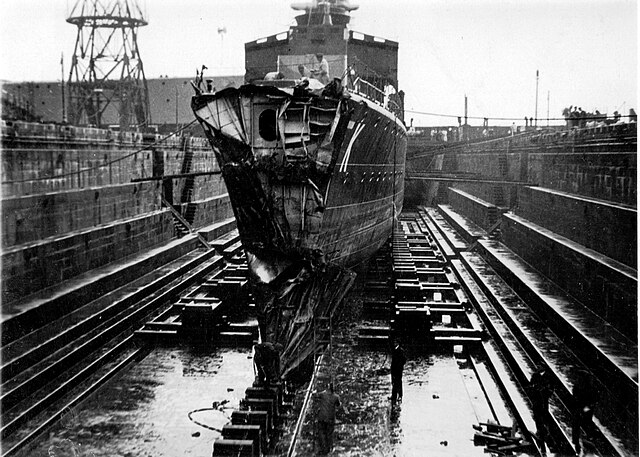
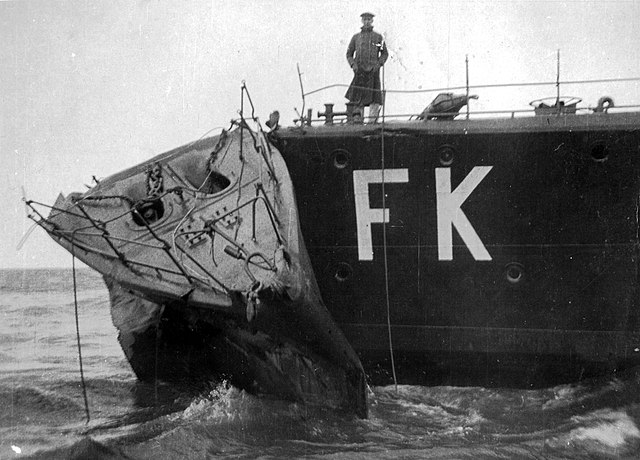
Falke (Falcon) was laid down at Reichsmarinewerft, yard number 106, on 17 November 1925, launched on 29 September 1926 and completed on 15 July 1928. Like her sisters she was in the 4th Torpedo Boat Half Flotilla, then full Flotilla, deployed several times in the Spanish Civil War. In 1939 she was in the 5th Torpedo Boat Flotilla and sent to escort the North Sea minefields ships before swapping on anti-contraband patrols in the Kattegat and Skaggerak in Octobver, November and December. Next in the Norwegian Campaign she joined Jaguar, assisting Lützow and wwent on to Kristiansand on 11 April. On 4–5 June 1940 she provided an ASW screen from Kiel to the Skaggerak and missed Allied convoys evacuating Norway, far from KMS Gneisenau, Scharnhorst and Hipper. From 21 to 23 June she escorted the badly damaged Scharnhorst from Norway to Kiel.
In the 5th Torpedo Boat Flotilla with Kondor, Jaguar, T2, T7, T8 escorted minelayers on the southwestern North Sea (7–8 August, 14–15 August, 31 August–2 September, 6–7 September) and with Wolf ventured off the Isle of Wight on 8–9 October, then on 11–12 October, managing to caught and sink two Free French submarine chasers and two British trawlers. Next she operated from St. Nazaire and helped with the minefield off Dover (3–4 December) and Channel (21–22 December). Sent to Norway with T12 she escorted a minelaying mission from Stavanger (26/27, 27/28 January, 3–4 February). She was refitted in Rotterdam from March to May 1941, transferred to the Skagerrak as convoy escort until January 1942, then reassigned to the 5th Flotilla for the Channel Dash.
From 12 March to 2 Apri she escorted KMS Michel through the Channel, managing to hit and kept at a distance HMS Walpole and Fernie. Next was KMS Stier (12-19 May), but on the 13th, she fought British MTBs which claimed her sister Seeadler and Iltis. She was refitted in Wilhelmshaven (June-August) and back to France with Kondor, T22, T23 to escort the Italian blockade runner SS Cortellazzo on 29–30 November and later Himalaya but she turned back when spotted by the RAF on 28 March 1943. Falke, Greif, Kondor, Möwe, T22 laid two minefields in the Channel on 4–6 June and started U-Boat escorts in the Bay of Biscay until August.
She was reassigned to Le Havre on 23/24 May 1944 with Möwe, Greif, Kondor, Jaguar, air attacked underway. Greif, badly damaged, accidentally collided with Falke, slightly damaged. With D-Day operations from 6 June her unit multipledsorties from Le Havre with little results. They were air attacked in the night of 14/15 June and she was sunk by bombs, direct hits and near-hits.
 Greif (1926)
Greif (1926)
Greif (Griffon) was laid down at Reichsmarinewerft on 5 October 1925, launched on 15 July 1926 and completed on 15 July 1927. Like her sisters she was part of the 4th flotilla, and took part in patorl sorties during the Spanish Civil War. From June 1938 she wa sin the 5th TB Flotilla.
Like her sister she escorted the North Sea minelaying of 3 September 1939, took part in anti-shipping patrols (Kattegat-Skaggerak) and from October to December controlled and captured ships.
In the Invasion of Norway she was in Group 4, commanded by Kapitän zur See Friedrich Rieve, flagship KMS Karlsruhe. She landed 90 soldiers to capture Arendal and its telegraph cable to England. She supported the 163rd Infantry Division and transferred the commander to oversee the operation. Next she departed for Kristiansand and then Wesermünde on 8 April after delays by heavy fog. When landing troops at Arendal she spotted the small TB HNoMS Jo, anchored with her bow towards the land andcaptain, Løytnant Thore Holthe left without orders he did nothing and Greif laft to proceed to Kristiansand until ordered to sail to Kiel asap and escort Karlsruhe with Seeadler and Luchs.
However while underway at 18:58, HMS Truant hit Karlsruhe amidships with one torpedoes of a 10-strong launch. She lost all power, steering, pumps. Luchs evaded the other nine, followed them to their origin and dropped depth charges (The Type 1923 were not equipped) and she chased the submarine for hours, joined by the other two and they lanaged to badly damage Truant, but she escaped. KsZ Rieve transferred his crew on the TBs, ordering Seeadler and Luchs ahead whikle her remained with Greif, which scuttled her with two torpedoes after taking back on board the staff. Lützow later was also torpedoes and assisted by Greif.
On 18 April, Greif, Möwe, Seeadler, Wolf escorted minelayers in the Kattegat and on 21-23 June escorted Scharnhorst from Norway to Kiel. She escorted a minelaying in the southwestern North Sea (14–15 August, 31 August–2 September, 6–7 September) and took part in a blank sortie off the Isle of Wight on 8–9 October and on 11–12 October with some kills. Next she was in St. Nazaire, took part in the minefield off Dover (3–4 December) and Channel (21–22 December).
After refit in Rotterdam in April-May 1941 she escorted ships through the Skagerrak, and received a major overhaul from December 1941 to December 1942 with many months working up. She was back in operations by 11 March 1943, escorting Tirpitz and Scharnhorst from Trondheim to Bogen Bay, and sailed to Altafjord with Lützow and Nürnberg (22-24 March) with Jaguar and later Z4, from Harstad to Trondheim and then Kiel on 3 May.
On 3–7 May, she took part in a North Sea minelaying and in June laid mines in the English Channel with her unit before swapping to the Bay of Biscay to escort U-boats in August before laying another minefield in the Channel on 29–30 September and off Le Havre and Fécamp on 21-22 March 1944. On 17–19 April they acted as distant cover for a convoy and later laid another minefield on 21/22 April, but were engaged the next night off Cape Barfleur by MTBs, repelling them. More monelaying missions followed in 26/27 and 27/28 April off Cherbourg, 30 April-1 May, always from Cherbourg before beong transferred to Le Havre on 23/24 May. But they were savaged by Allied aircraft the next day. Greif was struck by two bombs. Her forward boiler room was on fire and her bow was flooded. When all boilers rooms were fllled she lost steering and collided with Falke. Her bow was badly bent and took water when towed to port by Möwe but at 06:00 she lost all power, was abandoned and sank at 06:32.
 Kondor (1926)
Kondor (1926)
Kondor (Condor) was laid down on 17 November 1925, launched on 22 September 1926 and completed on 15 July 1928. She had the same career as her sisters in the interwar and was in the 5th TB Flotilla, taking part in North Sea mining operations in 1939. In the Norwegian Campaign she was in Group 5 (Oskar Kummetz, Blücher) bound for Oslo and she transported 100 men of the invasion force. She took part in the Battle of Horten Harbour: Whe tasked to occupy Karljohansvern on 9 April, Kondor’s captain, Kapitänleutnant Hans Wilck as commander of the force decided to assault the harbor directly since the Norwegians were alerted. 140 soldiers were carried by R17 and R21 and Albatros covered them at 04:35 at high speed while Kondor transferred her troops to another ship. HNoMS Olav Tryggvason engaged R17, set her on fire and hit R21 before escaping behind an island in the harbor. She was enngaged by Albatros without effect as in this ange she only had a single to bear. She was hit around 06:30. Meanwhile the German troops ashore bluffed the Norwegians into surrendering at 07:35.
Kondor and Albatros land troops at Son. Kondor and the minesweepers passed the Drøbak Sound after Blücher was sink, searching for survivors. Next she supported German forces occupying Drøbak. With Albatros she bombarded coastal batteries at Bolærne and occupied the island. Lützow was crippled on 11 April and escorted to safety by Kondor and Möwe. Later Olav Tryggvason surrendered and was captured, becoming a German minelayer.
Kondor, Möwe, Wolf and minelayers laid a minefield in the Skaggerak (29–30 April). 20–23 June saw Kondor escorting Scharnhorst to Kiel. In July she escorted Gneisenau from Trondheim. In the 5th TBF Kondor, Falke, Jaguar, T2, T7, T8 escorted minelayers in the southwestern North Sea on 7/8 August, 14–15 August. Next in the 1st TBF with T1, T2, and T3 in September she escorted a minelaying mission in the Channel but was rezazssigned to the 5th Flotilla and laid a minefield in the Channel on 1 October, took part in the Isle of Wight sorties in October, and was reassigned to St. Nazaire, laid mines off Dover in December.
She was refitted in Rotterdam from March to May 1941, transferred to the Skagerrak as Norwegian-Baltic escort, refitted in Rotterdam at the end of the year.
On 12 February 1942 she escorted the Channel Dash. From 12 March to 2 April she escorted the raider Michel and later the raider Stier and repelled MTBs in the Channel on May 13. Next she escorted SS Cortellazzo, Himalaya, laid two minefields in the Channel in June and until the fall, escorted U Boats in the Biscay to help (but detached for two minefields in the Channel in September).
The combined 4th and 5th TBF laid minefields off Le Havre and Fécamp in March and in April 1944 she sailed to Cherbourg as distant cover, laid a minefield on 21/22 April and battled British MTBs near Cape Barfleur. Later in April, they laid more mines near Cherbourg. During an aerial attacks Kondor struck a British mine, but damage was light. On 30 April and 1 May three more minefields were laid. Three weeks later she was transferred from Cherbourg to Le Havre, only to be attacked by Allied aircraft. Kondor escapoed unscathed, started a lengthy refit in Le Havre but ended cannibalized for spare parts, decommissioned on 28 June, bombed and declared a total loss on 31 July.
 Albatros (1926)
Albatros (1926)
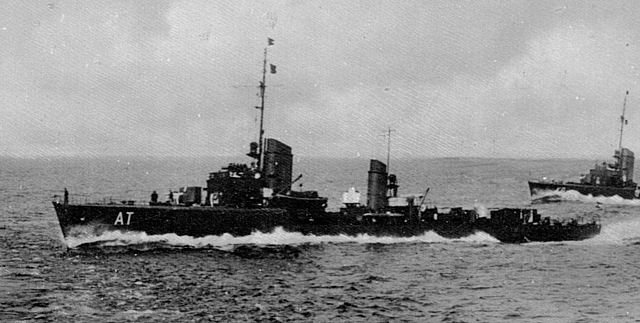
Albatros was laid down on 5 October 1925, launched on 15 July 1926 and completed on 15 May 1928. Her inetrwar records are a bit more detailed: At the start of the Spanish Civil War in 1936, her first mission from 28 July to 27 August with the 2nd Half-Flotilla was to escort KMS Köln, Deutschland and Admiral Scheer to the north Spanish coast to evacuate Germans and other refugees to France and many merchant ships chartered by Germany for such repatriations. She was back for the same from 28 September to 29 November but Seeadler ran aground while leaving Cadiz and she escorted her back home for repairs.
The 2nd Half-Flotilla was back again on May-June 1937 and on the 24th of May, Republican aircraft attacked Palma de Mallorca, forcing Deutschland to depart for Ibiza. Albatros remained and was near-missed by several bombs. She then departed for Ibiza. Deutschland was attacked there and a bomb killed several dozen crewmen. Retaliationwas ordered by Hitler which sent Admiral Scheer to flatten Almería escorted by the 2nd Half-Flotilla. On 31 May they also shelled Republican coastal artillery and killed 19. On 24 June Albatros was relieved by Möwe and escorted back home Köln and Leipzig.
Fall 1937 her unit was disbanded and she became TS, decommissioned on 16 February 1938, reactivated on 1 July 1938, assigned to the 6th TBF and transferred four months later to the 5th TBF with Greif, Möwe, Kondor, and Falke.
Here early WW2 carrer: Minefield in the north sea, and Norwegian campaign, as part Group (Blucher, later sunk). 8 April 1940 she depht charged and damaged HMS Triton off Skagen in Denmark. The night she arrived in the Oslofjord she received warning shots from HNoMS Pol III, and was rammed by her. Norwegian coastal batteries were alerted. Despite his order to hold fire, Captain Siegfried Strelow opened fire on Pol III, hir by gunfire and raked with machine guns. These were the opening shots of the campaign. She later capsized and men rescued by Albatros. She then proceeded to Oslofjord independently and caught Kondor, following her to Karljohansvern, Horten but en route, she was spotted by the minesweeper HNMOS Otra, radioing a report at 04:03 on 9 April.
Kondor’s captain decided to assault the harbor directly followed by Albatros, later engaged by HNoMS Olav Tryggvason which fired on R17. Albatros fired back without effect and withdrew behind an outer islands, blindly bombarding the harbor. She was hit once at 06:30, killing 2, wounding 2. She later withdrew and surrender was obtained at 07:35.
Next, Kondor and Albatros land their troops at Son and captured the submarine base at Teie. On 10 April, Kondor and Albatros duelled with coastal batteries and captured the island of Bolærne. Next she escorted SS Curityba bringing men on Rauøy and she started to steam east of the island to avoid Bolærne’s batteries. But sea ice removed the marker for the Gyren shoal and she hit it at 20 knots (37 km/h; 23 mph). One fuel tank was ripped open, one turbine and boiler rooms compartments flooded and she settled with a pronounced list to port, stern in the air. She soon lost all power, fires were ignited and she was soon declared a total loss. The crew was evacuated by Vorpostenboot V707 Arthur Dunker, late to the captured Olav Tryggvason (future KMS Brummer) after the Norwegian surrender.
 Seeadler (1926)
Seeadler (1926)

Seeadler (Sea Eagle) was laid down on 5 October 1925, launched on 15 July 1926 and completed on 15 March 1927. Her early carrer in the Spanish Civil War was the same as her sister Albatros. She was prsent when Dutschland shelled Almeria and herself bombarded the port. She went from the 2nd to the 4th then 6th TBF, was a TS and then decommissioned 1937-38. In September 1939 she took part in a north sea minefield operation, and in April 1940 for the Norwegian Campaign she was in Group 4 under Kapitän zur See Friedrich Rieve on Karlsruhe to Kristiansand. But spotted they wer soon targeted by the coast-defense guns at Odderøya Fortress at 05:32. Seeadler and Luchs returned fire without results, they were soon order to lay a smoke screen and the cruiser, loaded with troops withdrawn. Bomb support meant four He 111 from Kampfgeschwader 4 bombed the fortress buy tis did little but detonate an ammo dump. Rieve ordered another try at 05:55 and with all guns to bear on the fort, they were not hit but still proceeded with the landings ads the fort continued to fire, and withdrew once more at 06:23.
At 06:50 out of reach, he opened fire on the fortress and the TB stayed off due to the fog and narrows.
But the cruiser’s fire was ineffective and he withdrew around 07:30, requestinh additional air support. Later at 09:00 the fog briefly lifted but her nearly ran aground and withdrew, transferring his troops to E-Boats to proceed and storm the harbor supported by Seeadler and Luchs. Fortunately for the Germans when they waved a FR tricolor signal, the Norwegians believed these were allied and hold fire. This was over by 10:45. After withdrawing at 18:00, Karlsruhe was escorted by Seeadler, Greif and Luchs when tirpedoed 58 min later by HMS Truant, later chased down and damaged by Luchs, Seeadler, which later proceed ahead, leaving the cruiser to be evacuated and scuttled.
On 18 April she sortied with Möwe, Greif, and Wolf to lay an ASW minefield in the Kattegat. She was then refitted at Wesermünde in May-August 1940 and transferred to France, 5th Flotilla with Greif, Falke, and Kondor. They laid a minefield in the Channel on 1 October and sortied off the Isle of Wight with Wolf and Jaguar twice, having some success. They were sent to St. Nazaire, laid a minefield off Dover and the Channel in December. Later she sortied with Iltis and Z4 to lay mines at the northern entrance to the Channel on 23–24 January 1941. She was refitted in Rotterdam (March-May 1941) and transferred afterwards to the Skagerrak for convoy escort, refitted in Rotterdam from December 1941 to February 1942 and returned to the 5th Flotilla, took part in the Channel Dash. From 12 March to 2 April she ecorted Michel through the Channel and later Stier on 12-19 May however on the 13th, trying to find off British motor torpedo boats she was torpedoed, capsized, broke in half and sank rapidly with all hands.
Read More/Src
Books
Campbell, John (1985). Naval Weapons of World War II. Annapolis, Maryland: Naval Institute Press (NIP).
Friedman, Norman (2011). Naval Weapons of World War One: Guns, Torpedoes, Mines and ASW Weapons of All Nations.
Gröner, Erich (1990). German Warships 1815–1945. Vol. 1: Major Surface Warships. NIP
Haarr, Geirr H. (2010). The Battle for Norway – April–June 1940. Barnsley, UK: Seaforth Publishing.
Haarr, Geirr H. (2013). The Gathering Storm: The Naval War in Northern Europe September 1939 – April 1940. NIP
Haarr, Geirr H. (2009). The German Invasion of Norway, April 1940. NIP
Rohwer, Jürgen (2005). Chronology of the War at Sea 1939–1945: The Naval History of World War Two (Third Revised ed.). NIP
Sieche, Erwin (1980). “Germany”. In Chesneau, Roger (ed.). Conway’s All the World’s Fighting Ships 1922–1946.
Whitley, M. J. (2000). Destroyers of World War Two: An International Encyclopedia. London: Cassell & Co.
Whitley, M. J. (1991). German Destroyers of World War Two. NIP
Links
on german-navy.de/
on navypedia.org/
on en.wikipedia.org/
navweaps.com/ radars light kriegsmarine ships, TBs, DDs
more photos on commons.wikimedia.org
Videos
Model Kits
None ! Want one ? vote in the comments…
3D rendition

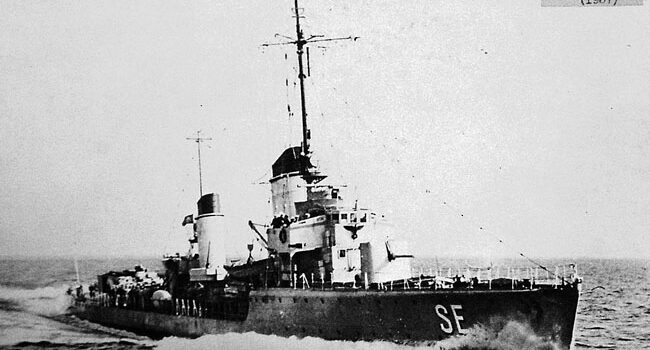

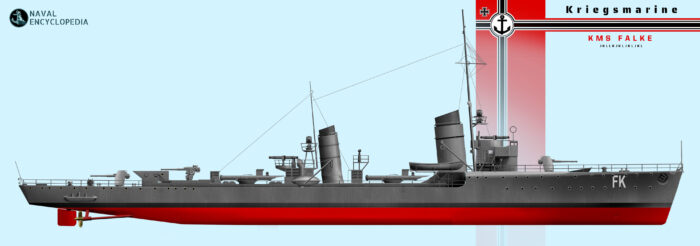
 Latest Facebook Entry -
Latest Facebook Entry -  X(Tweeter) Naval Encyclopedia's deck archive
X(Tweeter) Naval Encyclopedia's deck archive Instagram (@navalencyc)
Instagram (@navalencyc)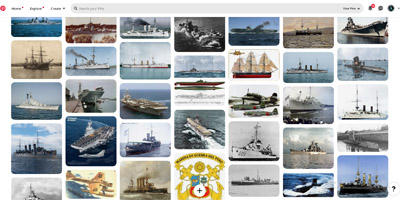

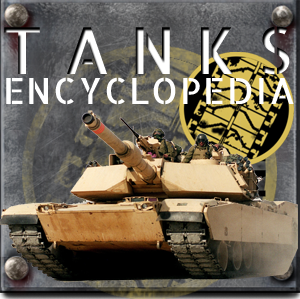
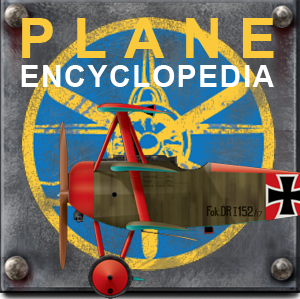
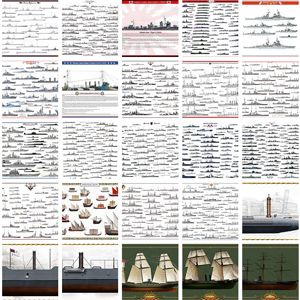
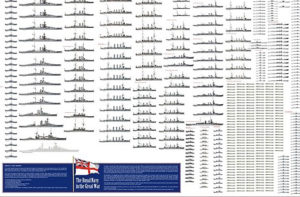
 French Navy
French Navy Royal Navy
Royal Navy Russian Navy
Russian Navy Armada Espanola
Armada Espanola Austrian Navy
Austrian Navy K.u.K. Kriegsmarine
K.u.K. Kriegsmarine Dansk Marine
Dansk Marine Nautiko Hellenon
Nautiko Hellenon Koninklije Marine 1870
Koninklije Marine 1870 Marinha do Brasil
Marinha do Brasil Osmanlı Donanması
Osmanlı Donanması Marina Do Peru
Marina Do Peru Marinha do Portugal
Marinha do Portugal Regia Marina 1870
Regia Marina 1870 Nihhon Kaigun 1870
Nihhon Kaigun 1870 Preußische Marine 1870
Preußische Marine 1870 Russkiy Flot 1870
Russkiy Flot 1870 Svenska marinen
Svenska marinen Søværnet
Søværnet Union Navy
Union Navy Confederate Navy
Confederate Navy Armada de Argentina
Armada de Argentina Imperial Chinese Navy
Imperial Chinese Navy Marinha do Portugal
Marinha do Portugal Mexico
Mexico Kaiserliche Marine
Kaiserliche Marine 1898 US Navy
1898 US Navy Sovietskiy Flot
Sovietskiy Flot Royal Canadian Navy
Royal Canadian Navy Royal Australian Navy
Royal Australian Navy RNZN Fleet
RNZN Fleet Chinese Navy 1937
Chinese Navy 1937 Kriegsmarine
Kriegsmarine Chilean Navy
Chilean Navy Danish Navy
Danish Navy Finnish Navy
Finnish Navy Hellenic Navy
Hellenic Navy Polish Navy
Polish Navy Romanian Navy
Romanian Navy Turkish Navy
Turkish Navy Royal Yugoslav Navy
Royal Yugoslav Navy Royal Thai Navy
Royal Thai Navy Minor Navies
Minor Navies Albania
Albania Austria
Austria Belgium
Belgium Columbia
Columbia Costa Rica
Costa Rica Cuba
Cuba Czechoslovakia
Czechoslovakia Dominican Republic
Dominican Republic Haiti
Haiti Hungary
Hungary Honduras
Honduras Estonia
Estonia Iceland
Iceland Eire
Eire Equador
Equador Iran
Iran Iraq
Iraq Latvia
Latvia Liberia
Liberia Lithuania
Lithuania Mandchukuo
Mandchukuo Morocco
Morocco Nicaragua
Nicaragua Persia
Persia San Salvador
San Salvador Sarawak
Sarawak Uruguay
Uruguay Venezuela
Venezuela Zanzibar
Zanzibar Warsaw Pact Navies
Warsaw Pact Navies Bulgaria
Bulgaria Hungary
Hungary

 Bundesmarine
Bundesmarine Dutch Navy
Dutch Navy Hellenic Navy
Hellenic Navy Marina Militare
Marina Militare Yugoslav Navy
Yugoslav Navy Chinese Navy
Chinese Navy Indian Navy
Indian Navy Indonesian Navy
Indonesian Navy JMSDF
JMSDF North Korean Navy
North Korean Navy Pakistani Navy
Pakistani Navy Philippines Navy
Philippines Navy ROKN
ROKN Rep. of Singapore Navy
Rep. of Singapore Navy Taiwanese Navy
Taiwanese Navy IDF Navy
IDF Navy Saudi Navy
Saudi Navy Royal New Zealand Navy
Royal New Zealand Navy Egyptian Navy
Egyptian Navy South African Navy
South African Navy






























 Ukrainian Navy
Ukrainian Navy dbodesign
dbodesign